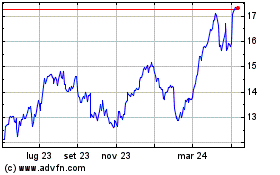ING Research: Customers Willing to Drop Brands Based on Perceived Environmental Impact
04 Febbraio 2020 - 2:31PM
Business Wire
Survey finds consumer adoption of circular
practices hinges on convenience, availability and understanding of
sustainable options offered by companies
A new global survey commissioned by ING shows consumer attitudes
have reached a tipping point, leading them to avoid brands that
don’t prioritize sustainability and environmental issues. Despite
demanding change, customers will still engage in the linear
‘convenience economy’ model of ‘take, make and waste’ unless
companies offer a more seamless transition towards the ‘circular
economy’. Faced with potential damage to profitability, businesses
must offer more convenient sustainable options to consumers in
order to create meaningful engagement with the circular principles
of ‘reduce, reuse and recycle’.
According to the new report, titled ‘Learning from consumers:
How shifting demands are shaping companies’ circular economy
transition’, the majority of respondents believe their behavior
and choices can have a positive impact on addressing global
environmental challenges (83 percent). Furthermore, 61 percent say
they would be less willing to buy a company’s product if they
discovered it was performing poorly on environmental practices.
The findings, which provide a detailed analysis of consumer
interactions with fashion, food and electronics brands, highlight
where consumers are already engaging in circular activities and
their appetite for new product and service models. The report notes
the potentially vast gains for businesses that embrace the ‘reduce,
reuse, recycle' principles of the circular economy by aligning with
consumers’ changing demands.
To better capture the opportunity of the circular economy and
engage with these customers, companies must first understand the
barriers to widespread consumer adoption. The barriers include:
- Awareness and education: In the electronics industry,
only 21 percent think companies provide detailed information on the
overall environmental impact of products; 41 percent don’t know
where to access repair services; 71 percent aren’t aware of
device-sharing platforms; and 39 percent can’t distinguish between
recyclable and non-recyclable plastics.
- Empowerment and reassurance: The top reason for not
repairing clothes is consumers’ belief that, to do so, they need
skills they don’t have, with 48 percent having this sentiment.
Meanwhile, concern about data security (42 percent) is the
second-most cited concern around leasing electronic devices.
- Circular infrastructure and convenience: Engagement with
more novel circular practices is being held back by the perceived
effort required: 41 percent think renting clothes would require a
lot more effort, and 36 percent say time is a barrier to repairing
devices.
- Cost: Price is still a decisive factor for many
consumers when buying clothes, food or electronic devices. More
than half (54 percent) of consumers still choose low-cost,
fast-fashion items over more expensive, more durable ones.
For companies to address these barriers for all of their
customers they need a deeper understanding of consumer motivation.
ING’s analysis identifies three broad groups: ‘Circular Champions’,
‘Circular Sympathizers’, and ‘Non-engagers’. The report identifies
within each industry sector the different buying decisions,
behaviors, and motivations of each group in embracing – or not –
circular economy practices. Through understanding the differences
in motivations from each consumer segment, brands can gain insight
into how to transition to circular business models while also
engaging those whose buying decisions are not based on
environmental factors.
In a related report issued last year, ‘Opportunity and
Disruption: How Circular Thinking Could Change U.S. Business
Models’, nearly four in five U.S. firms had a strategic intent to
implement a circular economy framework (62 percent) or had already
put one in place (16 percent). ING’s two circular economy reports
recognize businesses' and consumers’ progress in transitioning and
engaging with the circular economic model.
Methodology
- Longitude, a division of the Financial Times Group, surveyed
15,001 consumers in 11 countries across Europe, APAC and North
America during Q3 and Q4 of 2019.
- A nationally representative sample based upon age, gender and
income was targeted within each market.
- Consumers were asked about their attitudes and current
interactions with fashion, food and electronics brands, as well as
their appetite for emerging product and service models.
View the report here
https://www.ingwb.com/themes/circular-economy-articles/are-we-shopping-sustainably
ING profile
ING is a global financial institution with a strong European
base, offering banking services through its operating company ING
Bank. The purpose of ING Bank is empowering people to stay a step
ahead in life and in business. ING Bank’s more than 53,000
employees offer retail and wholesale banking services to customers
in over 40 countries. ING Financial Services LLC is a US subsidiary
of ING Bank.
ING Group shares are listed on the exchanges of Amsterdam (INGA
NA, INGA.AS), Brussels and on the New York Stock Exchange (ADRs:
ING US, ING.N).
Sustainability forms an integral part of ING’s strategy,
evidenced by ING’s ranking as Leader in the banks industry group by
Sustainalytics and ‘A’ rating in MSCI’s ratings universe. ING Group
shares are included in major sustainability and Environmental,
Social and Governance (ESG) index products of leading providers
STOXX, Morningstar and FTSE Russell.
View source
version on businesswire.com: https://www.businesswire.com/news/home/20200204005420/en/
Marrika van Beilen ING Bank M +31 6 54257830 E
Marrika.van.Beilen@ing.com Deepa Bose ING Bank T +44 (0)
207767 6346 M +44 (0) 7773 478 001 E
deepa.bose@ing.com Elaine Clark ING Financial Services LLC
T + 1 646 424 7021 M +1 917 945 2357 E
elaine.clark@ing.com
Grafico Azioni ING Groep NV (NYSE:ING)
Storico
Da Mar 2024 a Apr 2024

Grafico Azioni ING Groep NV (NYSE:ING)
Storico
Da Apr 2023 a Apr 2024
